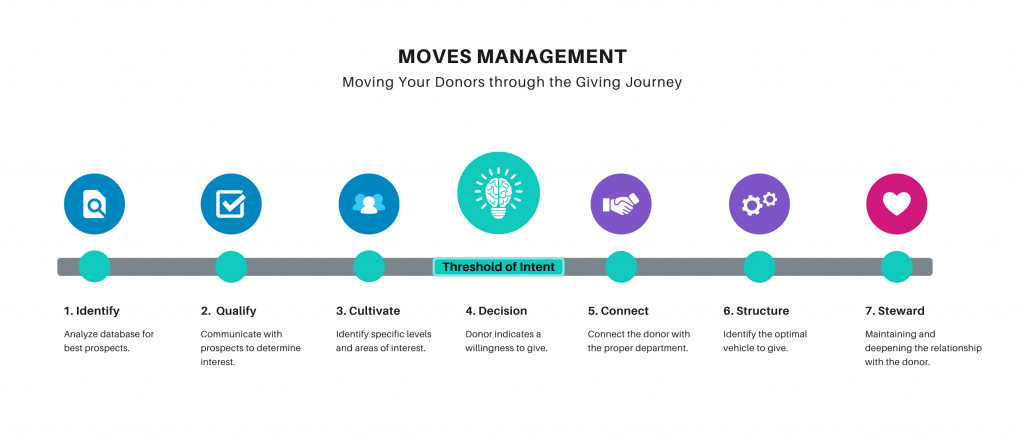
As a professional in the nonprofit sector, you will come across donors at various stages in their giving journey. Some donors may have already given to your organization, while others might have given to organizations with similar missions. These donors would, as a result, be more receptive to your request. On the other hand, some potential donors might not have enough current information about your organization, which could prevent them from becoming major donors and supporter.
Whatever the case may be, having a well-planned (and well-executed) strategy in place can help you identify prospective donors, cultivate relationships with them, and deepen these relationships over time.
Introducing Moves Management
Moves management is a systematic strategy through which you cultivate and foster relationships with donors. You are essentially identifying prospective donors and moving them from prospects to donors to repeat donors. A well-oiled moves management system helps your organization receive a steady stream of gifts from donors who trust you. As the trust builds, chances are, so will the amount they donate.
Why Your Organization Needs a Moves Management System
According to Bloomerang, “moves” are actions taken that move an individual from a prospective donor to a first-time donor, and eventually to a major donor. Each move is a progression in the donor lifecycle.
When implemented properly, a moves management strategy can prove to be invaluable for your nonprofit’s donor engagement and retention. Here are a few reasons you need a moves management system – stat.
- The system is used to help you understand where your donors are in the giving lifecycle.
- Since the donor is central to this system, you foster deeper and more meaningful relationships with existing and prospective donors. The goal is to cultivate life-long relationships with donors, allowing for continued giving.
- Moves management allows you to secure large gifts, such as year-end gifts and planned gifts.
- The system provides your fundraising efforts with a clear process that helps engage donors.
- A moves management system provides a nonprofit’s staff with a strategic process. They now know exactly what needs to be done to engage and foster relationships with donors.
- Since the system is divided into clear “moves”, it helps you pinpoint which activities are working and which ones aren’t. You can see which stages are the bottleneck and require further review or resources. This will help you double down on what works and abandon what doesn’t.

The Various Stages in Moves Management and How to Execute Them
The flowchart above provides us with a fairly clear understanding of how a donor moves from one stage to another in a moves management system. Let’s dive deeper into each stage.
STAGE 1: IDENTIFY
The first step in a moves management system is going through your existing database to identify the best prospects to approach. You want to find donors with the highest propensity to donate a major or planned gift to your organization. Affinity, capacity, and connection play a big role. How well do they know your organization? Do they engage with, and genuinely care about, your mission? And, of course, are they able to provide you with a gift?
STAGE 2: QUALIFY
In this stage, you segment and score your donors, as you try to understand whether somebody is a planned giving prospect, a major one-time donor, or a major periodic donor. Conducting in-depth wealth screening can be a part of this stage.
You can use tools such as DC Analytics to sift through unorganized and complicated data to save on time and organizational resources. The tool scores and qualifies prospects for you by looking at four key behavioral traits to determine a donor’s inclination to give.
STAGE 3: CULTIVATE
Cultivating long-lasting relationships with donors is all about thoughtful action. It might be the longest (and slowest) stage in the moves management system.
Here, you need to plan your moves in a manner that is personal, while also being in line with your donors’ interests. You must try and understand as much as you can about your donors. Why do they donate? And more specifically, why do they donate to your organization?
Communicating with donors in a personalized manner goes a long way. It helps them learn more about your organization and clears up any doubts they may have. It also helps you learn more about them and their lives. If your organization does not have the time or resources to personally connect with potential donors, take a look at our Donor Relationship Specialists. They will connect with potential donors on your behalf, both furthering the relationship as well as learning more about why they support your cause.
STAGE 4: DECISION
This is the stage where the donor indicates their willingness to give. The donor has crossed the threshold of intent, which is to say they have now decided to become a major gift or planned giving donor for your organization. This is a moment of celebration in the moves management system.
STAGE 5: CONNECT
Now that the donor wants to make a gift, you should make the experience of donating as seamless as possible. Connect them with the proper department and help them understand the process of donating to your organization.
STAGE 6: STRUCTURE
The sixth stage in a moves management system involves structuring the gift. This is when the gift transforms from desire to reality. Here, the intent of the gift is discussed, along with whether or not it will be a restricted gift — and if so, what the funds will be used for. When it comes to structuring the gift, estate lawyers, financial advisors, and family members might, and often are, involved. Your organization’s job is to make this process as easy for them as possible — whether it be having your paperwork in order or answering the donor’s questions in an efficient and timely fashion.
STAGE 7: relationship advancement
The last stage in a moves management system is relationship advancement. In order to build long-lasting relationships with your donors, simply thanking them isn’t going to cut it. You need to engage the donor even after a major or estate gift has been given.
Your donor needs to feel appreciated. They need to know that their donation matters and is making a positive impact. You should also keep them updated on how their donation is being used to further your cause, or in the case of a planned gift, how your organization intends to use it. Providing regular updates on the positive impact of their gift is key to successful relationship advancement. Consistent updates ensure that your donor trusts you and continues to give in the future. It is at this stage that you can take your donor back to the third stage (i.e. the cultivate stage) and encourage them to give again or support your cause in a new way.
Legacy societies are a great way of helping your donors feel engaged with your organization. A legacy society is an exclusive society that consists of your organization’s planned giving donors. It connects donors with fellow donors who share the same passion for your cause and organization. A legacy society helps your donors feel appreciated, connects them with other planned giving donors, and builds a sense of community. A legacy society, in essence, can help existing donors go back to the threshold of intent, thus donating again to your organization or increasing the size of their gift.
To Sum It Up
A moves management system will ensure you identify the right donors and move them along the seven stages in a systematic manner. It helps you save time and resources, while increasing your ROI. As the focus is on the donor, a moves management system will help your organization create lasting relationships with your donors. And remember, the key to a moves management system is to always keep moving!
Learn more about how Donor Compass™ can help you build strong relationships with your donors here.